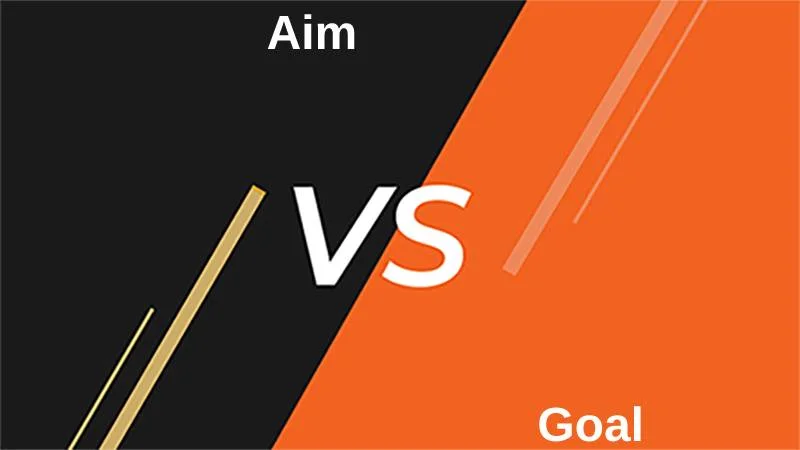As a child, you may have noticed that you aspire to be a scientist, a doctor, a professor, or any other successful individual. These are all the life aims that a person wishes to accomplish.
The terms aim, and goal are frequently interchanged since they both refer to what an individual or organization wants to accomplish. Both are the intended outcome of an individual’s labor but are based on different notions.
Aim vs Goal
The main difference between aim and goal is that the aim is a way to achieve specific targets and maintain the motivation to accomplish those targets. On the other hand, the goal is to have broader targets and work in that particular direction to achieve them.

The aim is a broad, general direction or purpose, lacking specificity and measurable criteria. It provides an overarching vision and context for actions, representing a long-term perspective.
A goal is a specific, measurable, time-bound, and actionable objective with clear targets. It includes criteria for assessing progress and success, providing a structured and focused approach.
While aims guide overall vision and values, goals are the actionable steps to achieve specific outcomes. Goals are built upon and derived from broader aims.
Comparison Table Between Aim and Goal
| Parameters of comparison | Aim | Goal |
|---|---|---|
| Definition | A broad and overarching direction or purpose. | A specific, measurable, time-bound, and actionable objective. |
| Specificity | Broad and general, lacking specific details. | Clear and precise, specifying exactly what needs to be achieved. |
| Measurability | Often lacks quantifiable metrics for success. | Includes criteria for assessing progress and success, quantifiable. |
| Timeframe | Long-term perspective, without immediate deadlines. | Has a set timeframe or deadline for achievement, adding a sense of urgency. |
| Flexibility | Can be flexible and adaptable, evolving over time. | Less flexible, with defined parameters and deadlines. |
| Purpose | Provides an overarching vision and direction. | Provides concrete targets and milestones. |
| Examples | “To promote global peace and harmony.” | “To increase revenue by 15% in the next fiscal year.” |
What is Aim?
An aim is a broad and overarching objective or direction one aspires to achieve. It represents a general purpose or intention without specifying specific details, measurements, or timeframes. Aims provide a guiding vision or aspiration that sets the course for actions, decisions, and efforts, offering a sense of purpose and direction in various aspects of life, including personal development, business, education, and social initiatives.
Key characteristics of an aim include:
- Broad and General: Aims are abstract and encompassing, addressing the “what” without delving into the “how” or “when.”
- Long-Term Perspective: Aims extend over a more extended period, sometimes even a lifetime, and may not have immediate or short-term milestones.
- Lack of Specific Metrics: Unlike goals, aims may not have quantifiable or measurable criteria for success. They are more about the overall vision and values.
- Flexible and Enduring: Aims tend to be adaptable and can evolve over time as circumstances change or new insights emerge.
- Guiding Principle: Aims serve as guiding principles that inform decision-making, strategies, and the pursuit specific goals.
Examples of aims include statements like “To promote global peace and harmony,” “To foster environmental sustainability,” or “To enhance the well-being of our community.” While aims lack the specificity and quantifiability of goals, they provide a broader sense of purpose and direction, serving as the foundational vision upon which goals and objectives can be built. Aims provide meaning and context to our actions, helping individuals and organizations align their efforts with their core values and long-term aspirations.
What is a Goal?
A goal is a specific, measurable, and time-bound objective that a person, organization, or entity sets to achieve within a defined period. Goals serve as concrete targets that guide actions and decision-making, providing clarity and direction toward a desired outcome. They are fundamental in various aspects of life, including personal development, business, sports, education, and project management.
Key characteristics of a goal include:
- Specific: Goals are clear and precise, defining exactly what needs to be achieved. They avoid ambiguity and vagueness.
- Measurable: Goals include criteria for assessing progress and determining when they have been successfully achieved. Quantifiable metrics are associated with goals.
- Time-Bound: Goals have a set timeframe or deadline by which they should be accomplished. This adds a sense of urgency and focus.
- Achievable: Goals should be realistic and attainable, considering available resources and constraints.
- Relevant: Goals are aligned with larger objectives, missions, or purposes, ensuring that they contribute meaningfully to the overall direction.
Setting and pursuing goals can lead to increased motivation, improved performance, enhanced productivity, and a greater sense of accomplishment. Goals are used in diverse contexts, such as career planning (career goals), project management (project goals), fitness (fitness goals), and financial planning (financial goals). They provide a structured framework for progress and success, enabling individuals and organizations to track their achievements and make informed adjustments.
Main Differences Between Aim and Goal
Aim:
- An aim is a broader, long-term, and general direction or purpose.
- It represents the overall objective or intention without specifying specific details or actions.
- Aims are more abstract and may not have measurable criteria for success.
- They provide a sense of direction and guide decision-making but lack specific targets.
- Aims are more flexible and adaptable to changing circumstances.
- Example: “To promote environmental sustainability and social responsibility in our business.”
Goal:
- A goal is a specific, measurable, time-bound, and actionable target.
- It defines a clear and specific achievement that can be quantified or evaluated.
- Goals are concrete and provide a clear path for planning and execution.
- They serve as milestones or checkpoints toward achieving broader aims.
- Goals are less flexible and should be achieved within a set timeframe.
- Example: “To reduce carbon emissions by 20% within the next two years.”